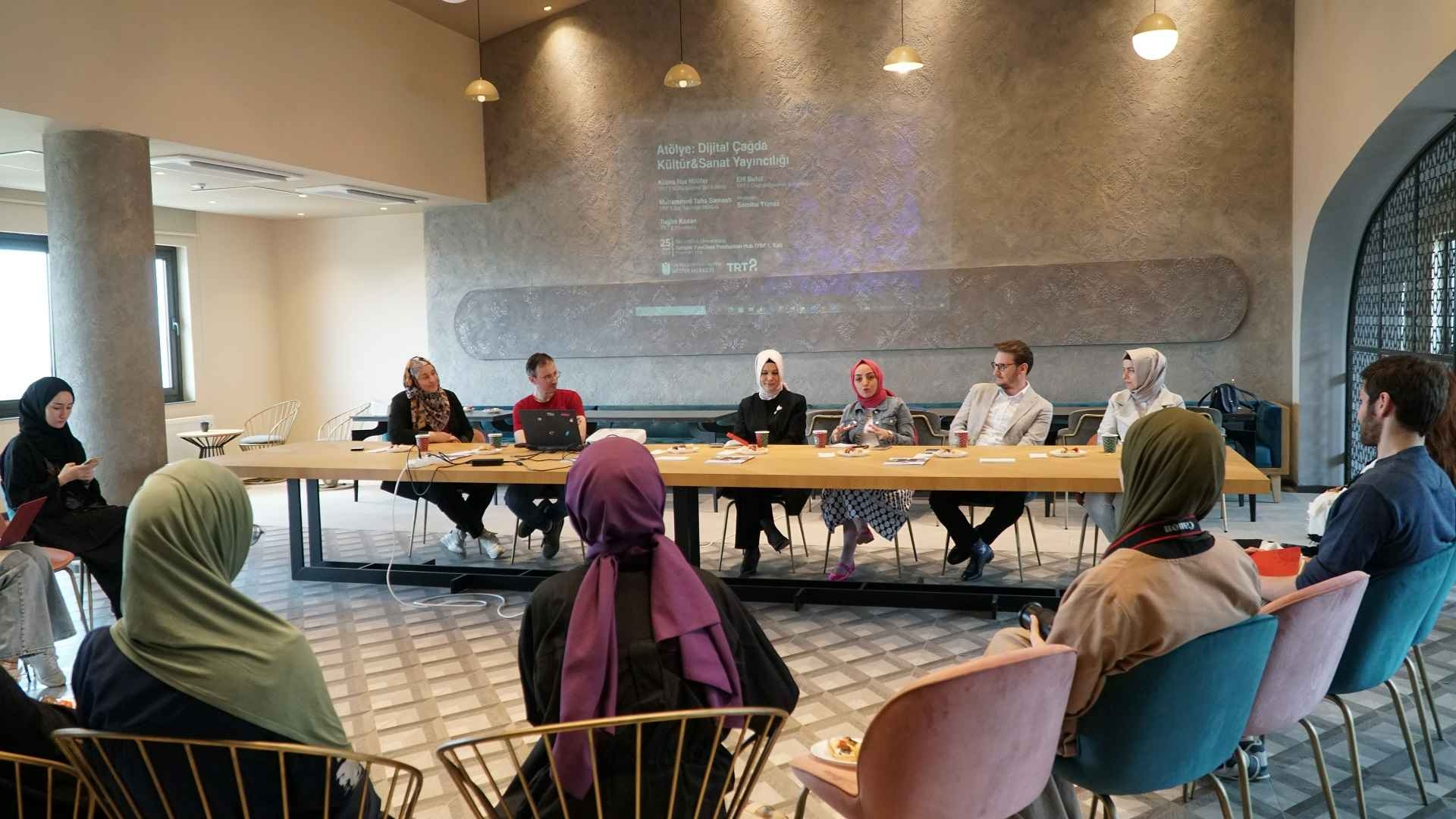


The "Culture & Art Broadcasting in the Digital Age" workshop program organized by our University Media Center and TRT 2 was held on Thursday, April 25 at the Faculty of Management Sciences.
TRT 2 Culture and Art Chief Editor Kübra Nur Nilüfer, TRT 2 Licensed Content Officer Elif Bulut, TRT 2 Foreign Productions Manager Muhammed Taha Samastı and TRT 2 director Tuğba Kozan were the guests of the program, which aimed to share the culture and art broadcasting experience that emerged in TRT 2 with student teams producing digital content at our University Media Center and students who want to join the Media Center in the future.
In the event moderated by Samiha Yılmaz from the Media Center, TRT 2's understanding of culture and arts broadcasting and evaluations about the digital era were made.
Stating that culture and arts broadcasting is a quiet field that enriches people, TRT 2 Licensed Content Officer Elif Bulut continued her speech by mentioning the importance of feeding oneself to create an original project. In her speech, Bulut stated that there is not a single unspoken word in the world and that everything imaginable has been said, so the important thing is how the idea or project is interpreted. Emphasizing the importance of being able to see things through someone else's eyes and to look at them with a different understanding, Bulut underlined the need to nurture and train oneself for this.
Stating that the content produced has not changed much, but media consumption habits have changed, TRT 2 Foreign Productions Manager Muhammed Taha Samastı stated in his speech that quality content somehow reaches the audience. Emphasizing that what is important is what the content tells and how it is told, Samastı said that things are slowly digitalizing and the screen we watch has changed. Samastı reminded that there was no traffic in Istanbul on Thursdays when the Valley of the Wolves series was broadcast because everyone was in front of the screen, and now we do not consume content from television because it is already on YouTube. He said that the content has also become longer and shorter in terms of duration, but if the content is strong, the platform and the screen do not matter much. Samastı stated that he cannot conclude that the content shot in TRT 2's virtual studio would not have been as successful if it had been shot in a normal studio, and emphasized that what matters is what we talk about, how we talk about it and how many minutes we talk about it. Samastı concluded his speech by stating that quality content somehow manages to reach the audience regardless of whether it uses digital or not.
Emphasizing the advantages of greenbox technology, Tuğba Kozan, one of the directors of TRT 2, said that thanks to greenbox, they can design the space they want, and that although it has handicaps, the benefits are much more. Stating that the possibilities provided by this technology are very special and beautiful, Kozan added that they can handle a shoot that would normally take days in a short time. Touching on culture and arts broadcasting, Kozan stated that TRT 2 has the task of being a bridge between the past and the future and that it provides a social memory. Stating that social memory is a field of struggle in itself, Kozan said that social memory has a very important place in the construction of civilization and that this social memory is provided through broadcasting and works of art. Tuğba Kozan, who stated that a work of art can give people the political and economic situation of that period, ended her speech by adding that she thinks that culture and art publishing is important when art has such a mission.
Drawing attention to important issues in creating and selecting content, TRT 2 Culture and Arts Chief Editor Kübra Nur Nilüfer said that the essence of the work is to tell an issue. Nilüfer stated that in the early ages of history, people tried to tell something with pictures drawn in caves or hieroglyphs in Egypt, and that they, as media professionals, also have the aim of telling something. When it comes to the issue of creating and selecting content, Nilüfer stated that one should go after the idea that beats in the heart and weighs on the mind instead of an idea that comes from the outside, and that there is something to tell there. Nilüfer added that news normally aims to answer 5N1K questions, but culture and arts journalism is a theater where exhibitions, art films and the last two seats are chased. Kübra Nur Nilüfer added that these are exactly what they cover, and emphasized that if you are doing journalism and have such a goal, the title of culture and arts is a sea of water.
In the last part of the event, a workshop was held where students were divided into groups to develop and present culture and arts program proposals. The students, who carefully examined the draft of the culture and arts program emphasized by TRT 2 Licensed Content Officer Elif Bulut, tried to develop their own ideas in a television program format with their group work. After the presentations made by the group representatives, the documentary proposal named "Street Artists" was selected as he winner by the jury formed by TRT 2 professionals. After the question and answer session, this productive program ended with the presentation of participation certificates and gifts to the participants.